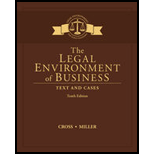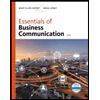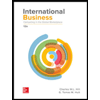
Lms Integrated Mindtap Business Law, 1 Term (6 Months) Printed Access Card Cross/miller’s The Legal Environment Of Business: Text And Cases, 10th
10th Edition
ISBN: 9781337093897
Author: Frank B. Cross, Roger LeRoy Miller
Publisher: Cengage Learning
expand_more
expand_more
format_list_bulleted
Question
Chapter 18, Problem 8BCP
Summary Introduction
Case summary: The companies R and B were co-owned by three brothers F, C and R. C speculated that F has deviated assets and funds from the company R to his own separate business. C filed a lawsuit against F on behalf of both the companies for breaching his fiduciary duties. However, F argued that C is incapable to understand financial statements.
To find: Maintainability of the action of C against F.
Expert Solution & Answer
Want to see the full answer?
Check out a sample textbook solution
Students have asked these similar questions
What is already being done to make mining in canada more sustainable?
What efforts are being made in order to make mining more sustainable?
I am looking for the correct answer to this financial accounting question with appropriate explanations.
Please help me solve this financial accounting problem with the correct financial process.
Chapter 18 Solutions
Lms Integrated Mindtap Business Law, 1 Term (6 Months) Printed Access Card Cross/miller’s The Legal Environment Of Business: Text And Cases, 10th
Knowledge Booster
Similar questions
- Please explain the correct approach for solving this financial accounting question.arrow_forwardProduct Lines and product Mix For the following assignment provide a visual example of product lines and their product mix for a brand of your choice. Product Line: Product Type: Product:arrow_forwardPlease provide the answer to this financial accounting question with proper steps.arrow_forward
- Can you solve this financial accounting question with the appropriate financial analysis techniques?arrow_forwardWhat are the environmental challenges the canadian mining industry face? Discuss current challenges that mining faces with regard to the environmentarrow_forwardWhat sustainability efforts have been put forth in the mining industry in canada Are your industry’s resources renewable or non-renewable? How do you know? Describe your industry’s reclamation processarrow_forward
- Can you help me solve this financial accounting question using the correct financial procedures?arrow_forwardI need guidance with this financial accounting problem using the right financial principles.arrow_forwardCan you solve this general accounting problem using appropriate accounting principles?arrow_forward
arrow_back_ios
SEE MORE QUESTIONS
arrow_forward_ios
Recommended textbooks for you
 BUSN 11 Introduction to Business Student EditionBusinessISBN:9781337407137Author:KellyPublisher:Cengage Learning
BUSN 11 Introduction to Business Student EditionBusinessISBN:9781337407137Author:KellyPublisher:Cengage Learning Essentials of Business Communication (MindTap Cou...BusinessISBN:9781337386494Author:Mary Ellen Guffey, Dana LoewyPublisher:Cengage Learning
Essentials of Business Communication (MindTap Cou...BusinessISBN:9781337386494Author:Mary Ellen Guffey, Dana LoewyPublisher:Cengage Learning Accounting Information Systems (14th Edition)BusinessISBN:9780134474021Author:Marshall B. Romney, Paul J. SteinbartPublisher:PEARSON
Accounting Information Systems (14th Edition)BusinessISBN:9780134474021Author:Marshall B. Romney, Paul J. SteinbartPublisher:PEARSON
 International Business: Competing in the Global M...BusinessISBN:9781259929441Author:Charles W. L. Hill Dr, G. Tomas M. HultPublisher:McGraw-Hill Education
International Business: Competing in the Global M...BusinessISBN:9781259929441Author:Charles W. L. Hill Dr, G. Tomas M. HultPublisher:McGraw-Hill Education

BUSN 11 Introduction to Business Student Edition
Business
ISBN:9781337407137
Author:Kelly
Publisher:Cengage Learning

Essentials of Business Communication (MindTap Cou...
Business
ISBN:9781337386494
Author:Mary Ellen Guffey, Dana Loewy
Publisher:Cengage Learning

Accounting Information Systems (14th Edition)
Business
ISBN:9780134474021
Author:Marshall B. Romney, Paul J. Steinbart
Publisher:PEARSON


International Business: Competing in the Global M...
Business
ISBN:9781259929441
Author:Charles W. L. Hill Dr, G. Tomas M. Hult
Publisher:McGraw-Hill Education
